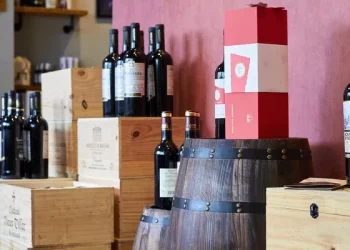In recent years, more and more winemakers are looking for inspiration from the original winemaking process to further enhance the quality of wine.
For example, some winemakers have chosen to return to the tradition of not stalling the whole bunch of grapes after they have been picked and allowing the grapes to ferment together with the stems, known as peduncle fermentation, or whole bunch fermentation.
Whole bunch fermentation is the most primitive method of making red wine.
Before the invention of pedunculating machines in the 20th century, almost all red wines were made by pedunculating fermentation.
Wines made during this period tend to have rough tannins, especially when the stems are not fully ripe.
Today, most grapes are destemmed before fermentation, but the technique can still be used to style a wine, and is commonly used to make Pinot Noir and Syrah wines.
Domaine de la Romanee-Conti (DRC) in Burgundy, Domaine Leroy and Domaine Dujac all use this method to create unique wines.
Stem fermentation affects the aroma, texture and tannin structure of a wine.
Using fully ripened stems not only avoids hard tannins and abrupt green flavors, but also gives the wine fresh flavors of flowers, herbs and spices.
The involvement of the grape stem in the fermentation process reduces the temperature in the fermenter and makes it more stable, resulting in a milder extraction of tannins and flavours and a more delicate and fresh wine.
The stems also contain phenolic compounds that enhance the tannin structure of the wine.
Peduncle fermentation also reduces the alcohol content of the wine.
Grape stems contain a lot of water instead of sugar, so no more sugar will be converted into alcohol in the fermentation process. In addition, as the whole bunch fermentation is usually carried out in an open fermentation container, part of the alcohol will evaporate in the fermentation process, which relatively reduces the alcohol content of the wine.
In addition, the potassium contained in the stem binds to the tartaric acid in the wine and forms a precipitate, reducing the overall acidity of the wine.
Fermentation grape stem can also absorb part of the wine in the pigment, so that the wine color is lighter, more transparent.
Pedunculated fermentation can be carried out by keeping all the grapes in their stems, by placing part of the grapes in a whole bunch in a fermenter with depedunculated grapes, or by adding some pedunculated grapes after all the grapes have been depedunculated and broken.
In the process of stem fermentation, some whole bunch of grapes may be deposited by gravity to the bottom of the fermenter and begin the fermentation due to lack of oxygen.
This is similar to, but not identical to, Carbonic Mration.
In THE CARBON DIOXIDE IMPREGNATION METHOD, THE WHOLE BUNCH OF unBROKEN GRAPES NEEDS TO BE FILLED WITH CARBON DIOXIDE and sealed after being PUT INTO THE FERmenter, WHEREAS THE FERmenter DOES not need to be sealed for stem fermentation.
The process of Whole Bunch Pressing can be used to make white wine, in which a bunch of stemmed fruit is pressed directly into a press after the grapes have been harvested. The presence of stems helps to create Spaces between the fruits, allowing the juice to flow out more easily.
Compared with the common method of “peelling and peeling before pressing”, whole bunch pressing can shorten the contact time between grape juice and grape skin, thus reducing the extraction of color and phenols, resulting in clearer grape juice and a more refined and elegant wine style.
The latest market dynamics at any time to see, please pay attention to.












































